|
|
Domitian Obelisk (In Museo del Sannio, Benevento)
| Present Site: | Museo del Sannio, Benevento, Italy N 41°07'03.0"(41.129816) E 14°46'52.9"(14.781353) |
| Pharaoh: | Roman Emperor Domitian (Domitianus) (AD 1st Century) |
| Measurement: | 2.28 meters high for obelisk itself, 66 cm for the pedestal |
| Weight: | Unknown |
| Stone: | Red granite |
About The Site:
There are two obelisks standing in Benevento, small town in Italy. One of them is exhibited here in Museo del Sannio, the Annex.
Although Lombard of Germanic invaded into Italy in 568 after the Roman Empire downfall, Lombard has caused the Duchy of Benevento in Benevento.
In 2011, it became a UNESCO World Heritage Site as part of a group of seven inscribed as Longobards (Lombard) in Italy, Places of the Power (AD 568-774). The church of Santa Sofia including Museo del Sannio is one of seven inscribed heritages.
The church of Santa Sofia: The church of Santa Sofia was built in around AD 760, under the influence of Hagia Sophia (Ayasofya) in Istanbul. Although I couldn't well understand the importance of this church, but the cloisters in the Museo del Sannio are very impressing. Different designs on each pillar are interesting. So, most visitors seem to be interesting in the Cloisters than the church of Santa Sofia.
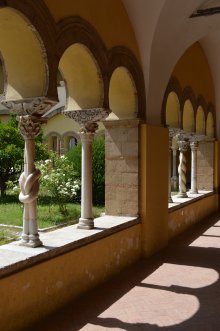 The Cloisters in the Museo del Sannio
The Cloisters in the Museo del Sannio
|
Talleyrand Obelisk: There is a noticeable obelisk in front of the church. However, this is nether Egyptian nor Ancient Roman obelisk, but this is a modern obelisk in 19th century. Although no inscription is on the obelisk itself, the Italian text "FONTANA CHIARAMONTE A MDCCCIX" (Chiaramonte Fountain in 1809) is inscribed at the pedestal. According to Wikipedia site of "Monumental Complex of Santa Sofia" in Italian, a French politician and diplomat Talleyrand (the Prince of Benevento, at that time) made it in 1809 when the time Napoleon had dominated Italy. The initial inscription (at the pedestal) was scraped off After 1814 when Napoleon's Italian Kingdom ended, and the ruler of Benevento was changed, then the inscription was replaced with the current text.
The Annex: The exhibition rooms of Museo del Sannio are in the three-story building. When I visited here in August 2014, only the sculptures and pottery works of Greek Period were exhibited, and about the legend of the witches of Benevento was explained, but no Egyptian-related exhibitions were found. I felt someting strange, and wanted to ask the museum staff, but I couldn't communicate them because no staff understood English. Then I showed them a pictute of obelisk, they finally understood what I was looking for and brought me to the building opposite side of the street. The building was for Museo Arcos (Museo d'Arte Contemporanea Sannio), and the "Annex" (of the Museo del Sannio) was in this building. All the Egyptian-related exhibitions had moved to here. Since the entrance of "Annex" was not completed in 2014, nobody can be aware of this "Annex" without the museum staff's guide.
As for the Egyptian-related exhibitions, unearthed articles which were discovered in the ruin area of Isis Temple near the triumphal arch, the Arch of Trajan, excavated by Almerico Meomartini (an architect, archaeologist, and politician in Italy), such as the sculptures of Goddess Isis and God Horus are exhibited. Among them I was impressed the small sculpture of Domitian (Domitianus) imitated by the Egyptian Pharaoh style.
How To Get There:
Please refer here for the way to Benevento and Piazza Papiniano. From that Piazza Papiniano, walk east about 200 meters further along the Corso Giuseppe Garibaldi, then you can see the tall bell tower at left side. Left front of the bell tower, here is a square with the obelisk (Talleyrand Obelisk, see above). The church in the back is Santa Sofia, and the Museo del Sannio is in the old Monastery, next to the church. The tickets for Museo and Church are sold as a set.
About The Obelisk:
Two obelisks are exhibited in the Annex of the Museo del Sannio. Among them, one is the one of pairs of Domitian Obelisk in Piazza Papiniano (in Benevento). According to the Museum (Museo del Sannio), this was discovered in 1903, and acquired in the Museum in 1916.
Although only the front and left sides of the obelisk can be seen (See pictures below) here, but I could confirm this obelisk is with the pair of obelisk in Piazza Papiniano, as the front side [of this obelisk] is same to the south side of [the obelisk in Piazza Papiniano] and the left side [of this obelisk] is same to the east side of [the obelisk in Piazza Papiniano] The top of the obelisk is missing, but the inscription at the lower portion was well conserved.
Another obelisk in this Museo del Sannio, is just a fragment (See pictures below). According to the explanations of Museum, this is of 2nd - 4th century, and this was discovered in Piazza Caridinal Pacca, near to the Duomo of Benevento. The most hieroglyphs are missing, but the museum estimates the meaning of "Son of Re".
According to the report by local TV Station Canale 58, dated June 3rd 2016, this obelisk will be leased for an exhibition on the theme of Egypt which will be held at the Paul Getty Museum in Los Angeles in 2018. And, this will be restored by the Paul Getty Museum as a cultural cooperation framework of the Paul Getty Museum. The shipping date is unknown, but this may be shipped in 2017, after some restoration works are done.
Notes For Pictures:
I took the pictures of Domitian Obelisk in this museum with a flash light, getting a permission of the museum staff, as this was set at the poor lighting location. In addition, I could take pictures only the front and left sides, because the obelisk is set at the corner of the exhibition room. The explanation plate was on the right side wall, but I didn't rearise it until I came back to Japan. This was included in the picture of left side (of obelisk). But the picture was focused on the obelisk, and the explanation plate was out of focus, and it was unreadable.
Due to probably a summer vacation season when I visited here in 2014, little visitors, only 4 other people are in the museum.
Since I could take pictures only the front and left sides, the pictures of the fragment of obelisk (in this museum) and Talleyrand Obelisk in front of Santa Sofia are posted below.
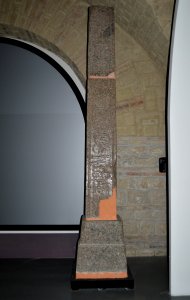 Front Side |
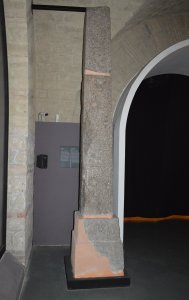 Left Side |
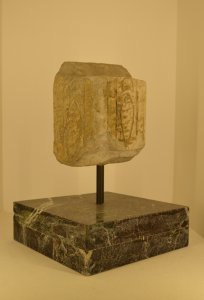 Fragment of the Small Obelisk |
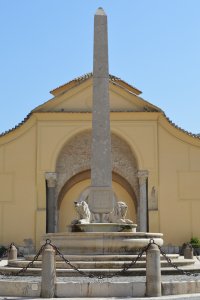 Talleyrand Obelisk |
|||
August 13, 2014 by Hiroyuki Nagase (For high definition image, please click the picture) | ||||||
Copyright Hiroyuki Nagase nagase@obelisks.org and Shoji Okamoto okamoto@obelisks.org